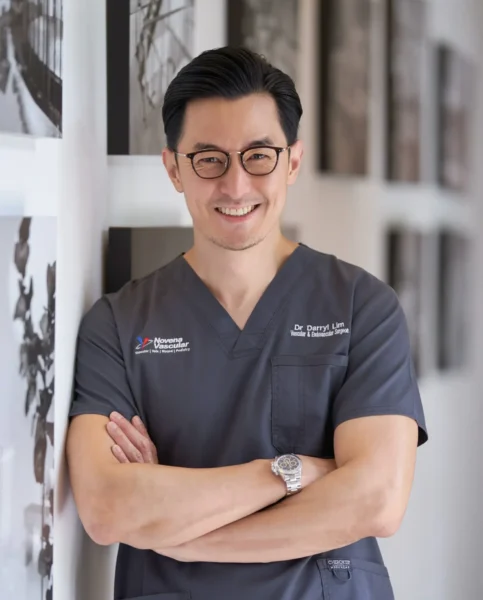VenaSeal
What is VenaSeal?
VenaSeal is a next-generation, minimally invasive treatment that targets venous reflux disease by sealing affected veins with a specialized medical adhesive. When veins in the legs become incompetent—often due to malfunctioning valves—blood can pool instead of flowing efficiently back to the heart. This backward flow, known as venous reflux, can lead to pain, swelling, and the development of varicose or spider veins. VenaSeal tackles the problem at its source by closing off the unhealthy veins so that blood naturally reroutes to healthier pathways.
How VenaSeal Works
Unlike thermal-based treatments such as laser or radio frequency ablation, VenaSeal uses an adhesive to seal the problematic vein. Because no heat is involved, patients generally experience minimal discomfort. The sealed vein then undergoes a natural process known as fibrosis, during which the body absorbs and removes the treated section over time.
This approach eliminates the need for sclerosing agents or multiple needle sticks, which many people find reassuring if they’re nervous about more invasive vein procedures.
The Procedure: What to Expect
A typical VenaSeal session begins with a detailed ultrasound examination, allowing your vascular surgeon to map the exact course of the affected veins. Local anesthesia with sedation is often sufficient for this procedure, although general or spinal anesthesia may be considered if you’re also having concurrent varicose vein removal for comfort’s sake. Once you’re prepared, a small catheter is inserted into the diseased vein under real-time ultrasound guidance. Through this catheter, the medical adhesive is delivered in precise doses, effectively sealing the vein.
Because the adhesive works quickly to seal the vein walls, blood flow is promptly rerouted to healthier vessels. The entire process usually takes 30 to 45 minutes, and any sensations of discomfort are often mild and short-lived. Many patients appreciate that VenaSeal requires fewer injections than other venous treatments, helping to make the experience more comfortable overall.
Post-Procedure Recovery
One of the main advantages of VenaSeal is its quick and relatively easy recovery period. Whether the procedure takes place in a day surgery center or an outpatient clinic, you can typically return home on the same day or by the next morning. Walking is encouraged almost immediately, as light activity supports healthy circulation and reduces the risk of complications. Most people resume their normal routines within a few days, and many find that they can go back to exercising within about two weeks.
An additional benefit of VenaSeal is that compression stockings—often worn for one to two weeks after thermal ablation—are typically not required post-procedure. This makes daily life simpler, especially for those who find compression garments cumbersome or uncomfortable.
Potential Risks and Complications
Although VenaSeal is considered safe and minimally invasive, every medical intervention carries some degree of risk. A small percentage of patients may experience allergic reactions to the adhesive, localized inflammation known as phlebitis, or, more rarely, deep vein thrombosis (DVT). However, because VenaSeal does not involve heat, the risks associated with thermal damage—such as skin burns, nerve injury, and extended bruising—are substantially reduced. By avoiding heat, VenaSeal aims to deliver a gentler experience that still delivers effective results.
Why Choose VenaSeal?
When weighing vein treatment options, VenaSeal offers several advantages:
- Minimized Discomfort: The absence of heat means fewer injections.
- Rapid Recovery: Many patients can return to work and daily activities within days.
- No Compression Stockings: Unlike other vein procedures, VenaSeal usually does not require wearing compression garments during recovery.
VenaSeal can be particularly appealing if you are looking for an efficient, minimally invasive solution to your varicose veins and symptoms related to venous reflux. It delivers a strong balance of efficacy and comfort, enabling a smoother treatment experience and helping you move forward with less interruption to your daily life.
If you’re curious whether VenaSeal could be the right choice for you, reach out to Dr. Darryl Lim to schedule a consultation and explore how this treatment might fit into your personalized care plan.
This information is provided as a general guideline and should not replace professional medical advice. Always consult your healthcare provider for recommendations tailored to your unique situation.
FAQ's about VenaSeal
VenaSeal is a minimally invasive procedure designed to treat venous reflux, the underlying cause of varicose veins. It uses a medical adhesive to close the faulty veins, preventing the backward flow of blood.
VenaSeal employs a specially formulated medical adhesive delivered through a small catheter to close the affected veins. This stops the blood from pooling, alleviating the symptoms of varicose veins and allowing blood to reroute through healthier veins.
Yes, VenaSeal is considered a safe and FDA-approved treatment for venous reflux. It has been subject to clinical studies demonstrating its efficacy and safety.
Recovery time is minimal, with most patients returning to their normal activities within a few days. There is typically no need for compression stockings post-procedure.
Unlike thermal-based treatments like Radiofrequency Ablation, VenaSeal does not require multiple tumescent anesthesia injections and does not cause thermal injury, reducing pain and bruising post-procedure.
Most patients report feeling little to no pain during the VenaSeal procedure. Some may experience minor discomfort or a slight pulling sensation, but this is generally well-tolerated.
Spider veins are usually treated with other modalities like injection sclerotherapy.
The risks are generally mild and may include allergic reactions to the adhesive, inflammation, phlebitis, or infection. Deep venous thrombosis (DVT) is a rare side effect, that will require treatment.
Most side effects are temporary, resolving on their own or with minimal intervention.
The procedure usually takes approximately 30 to 60 minutes, depending on the number of veins being treated.
Coverage for VenaSeal may vary, and it is recommended to consult with your insurance provider regarding the specifics of your policy.
Generally, VenaSeal is a single-session treatment, but individual cases may vary, and some patients may require additional treatments depending on the extent of the venous disease.
Yes, patients are usually encouraged to walk immediately after the VenaSeal procedure to promote blood flow.
Most patients can return to work and resume normal activities within a few days after undergoing VenaSeal, but it may vary depending on individual recovery.
Clinical studies have shown VenaSeal to be highly effective in treating venous reflux disease with a high success rate and low recurrence of varicose veins.
Dr Lim specialises in the treatment of vein disorders such as varicose veins and spider veins. With extensive experience and a commitment to individualized care, Dr. Lim ensures that each patient’s needs and concerns are addressed.
Schedule a consultation with us to discuss whether VenaSeal is the right treatment option for you.


